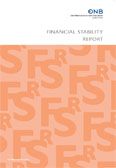Financial Stability Report 12
 OeNB
OeNB
- published:
- December 2006.
 OeNB
OeNB
Financial Stability Report 12 (PDF, 1.7 MB) December 2006.
Austrian Financial System Benefits from Good Economic Conditions (PDF, 55 kB) Financial Stability Report 12 en Dec 15, 2006, 12:00:00 AM
Robust International Economy Fuels Recovery of Financial Markets Following Corrections in Spring (PDF, 467 kB) Financial Stability Report 12 en Dec 15, 2006, 12:00:00 AM
Financing Conditions for the Real Sector Deteriorate Marginally (PDF, 227 kB) Financial Stability Report 12 en Dec 15, 2006, 12:00:00 AM
Austria’s Financial Intermediaries Are on a Dynamic Growth Path (PDF, 314 kB) Financial Stability Report 12 en Dec 15, 2006, 12:00:00 AM
Booming, but Risky: The Ukrainian Banking Sector – Hot Spot for Foreign Strategic Investors (PDF, 192 kB) Barisitz. Barisitz – Financial Stability Report 12 This paper gives an overview and assessment of the evolution of the Ukrainian banking sector since the outset of transition, focusing on the most recent developments. While the 1990s saw turbulent changes against the backdrop of continuous economic contraction, the Ukrainian banking sector has been on a strong expansion path ever since the turn of the millennium, a path which appears to have been only briefly interrupted by the minor crisis of late 2004 and early 2005. Although the National Bank of Ukraine has certainly improved banking regulations and supervision, the country’s credit boom (sevenfold real increase of credit volume between 2000 and 2005, albeit from a modest base) has raised serious concerns about credit risks. Financial fragility continues to loom large in an environment where the practice of "pocket banking" (credit institutions acting as extended financial departments of owner firms) is still widespread. Over the past months, foreign strategic investors have started to move in: Led by Raiffeisen, which purchased the second-largest Ukrainian bank in October 2005, takeovers and business expansions have raised foreigners’ share in total banking assets from 13% to 26% within a year. Austrians account for somewhat less than half of all foreign-owned banking assets in Ukraine. en Banks E0, E5, G21, G28, P34 Dec 15, 2006, 12:00:00 AM
Modeling Dependent Credit Risks for Application to Off-Site Banking Supervision (PDF, 353 kB) Glogova, Warnung. Glogova, Warnung– Financial Stability Report 12 During the past five years the Oesterreichische Nationalbank (OeNB), together with the Austrian Financial Market Authority (FMA) and university experts, has developed and implemented several modern tools for the purposes of off-site banking analysis and supervision. One of these tools is the Value-at-Risk (VaR) model, which allows for the standardized quantification of every single bank’s economic capital. Within this portfolio model framework, a total VaR is calculated as an aggregation of credit, market and operational VaR, assuming perfect correlation between the risk categories. The methodology for measuring the credit risk of a bank’s portfolio is currently based on the standard CreditRisk+ model, an actuarial model for aggregating risks in a credit portfolio with a single risk factor. In 2005 the OeNB and the Vienna University of Technology launched a research project with the aim of developing an extended version of the credit risk model that is able to account better for portfolio diversification effects. As the background risk factors in the standard CreditRisk model have to be orthogonal, resemblance to real-world industrial sectors or other macroeconomic factors, which often appear to be strongly correlated, is not possible. This paper gives an overview of our approach to modeling correlations among systematic risk factors. Other extensions of the model, like the ability to calculate a single obligor’s risk contribution and the incorporation of stochastic loss given default, are touched upon. en Financial Stability C16, C65, G38 Dec 15, 2006, 12:00:00 AM
Austrian Banks’ Lending and Loan Pricing Strategies against the Background of Basel II (PDF, 170 kB) Jäger, Redak. Jäger, Redak – Financial Stability Report 12 Although the New Basel Capital Accord (Basel II) makes no direct reference to loan pricing and lending terms, it is widely held that Basel II does, in fact, impact on loan pricing. A survey among Austrian banks on loan pricing strategies after Basel II aimed to identify the potential effects of Basel II on loan pricing. This article summarizes and analyzes the results of this survey and their implications for the Austrian lending business. The survey found a significant trend toward risk-adequate pricing. While it is impossible to predict at this point whether banks will eventually successfully implement this strategy, given the competitive environment, it seems that they are in fact resolved to do. Banks’loan pricing and portfolio streamlining plans concern mostly lending to small and medium-sized enterprises (SMEs), which in credit institutions’ view offers the largest room for maneuver to adjust lending volumes and prices. en Banks, Basel II G21, L22, D4 Dec 15, 2006, 12:00:00 AM
Determinants of the Interest Rate Margins of Austrian Banks (PDF, 278 kB) Liebeg, Schwaiger. Liebeg, Schwaiger – Financial Stability Report 12 Bank interest rate margins have been declining in most EU Member States over the last decade. Drawing on a unique sample of supervisory data for the Austrian banking system from 1996 to 2005, this paper investigates the determinants of bank interest rate margins. The main factors driving the reduction of Austrian banks’ interest rate margins are decreasing operating costs, the growing importance of foreign currency lending combined with a rising share of non interest revenues as well as increasing competition. In contrast to findings in the literature we document a positive effect of relationship banking on margins, with the erosion of relationship banking being another reason for the decline in interest margins. en Banks G21, E40, C33 Dec 15, 2006, 12:00:00 AM
Annex of Tables (PDF, 198 kB) Financial Stability Report 12 en Dec 15, 2006, 12:00:00 AM